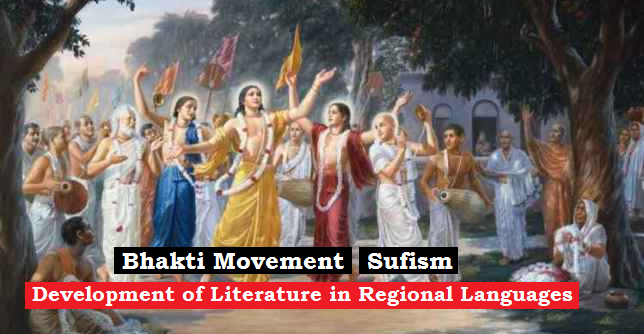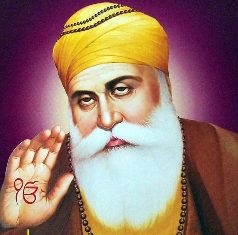
Bhakti Movement
Background:
Bhakti Movement which stresses mystical union of the individual with God was there before the arrival of Turks.
Lord Vishnu was worshiped as a personal God, many holy books were re-written in Gupta period and Bhakti was accepted as one of the means to salvation along with Jnana and Karma.
Development:
- Nayanars and Alvars:
- During 7-12 century Bhakti took the real shape in South India where Shaiva Nayanars and Vaishnavite Alvars preached personal devotion to God as a means of salvation and disregarded the sacrifices of Jainism and Buddhism.
- They criticized the social distortions prevailing- caste rigidities, Brahamanism rituals and sacrifices, and emphasized on the love and personal devotion to God.
- The medium of preaching was the local language and the spread of Bhakti ideas took time to reach to the north by the saints and scholars like Namadeva (Marathi saint), Ramananda.
- Ramananda was a follower of Ramanuja who taught Bhakti to all varnas and criticized the caste system. His disciples included: Ravidas (cobbler by caste), Kabir (weaver), Sena (barber), Sadhna (butcher), etc.
Spread:
- After the establishment of Turkish Sultanate, Brahamanism was losing appeal and as a result many movement started challenging the caste system and superiority of Brahamans (Nath Panthi Movement).
- It coincided with the Islamic ideas of equality and brotherhood, and people wanted a new religion which could satisfy their reason and emotions and Bhakti Movement became a popular movement (during 15-16 century).
- Non- sectarian nature: It became mostly non- sectarian movement with a criticism of the social order, rituals and unity of God, modern ideas of equality and brotherhood with emphasis on Hindu- Muslim unity were preached.
- Vaishnavite Movement:
- With non-sectarian nature of Bhakti movement, it also developed around the worship through love and devotion of Rama and Krishna and their lives became the theme of preaching and devotion.
- They preached worship through love and devotion of their God and welcomed people from every caste. They adopted song and music to produce a state of bliss to realize God.
- However, they did not attack the rituals and remained within the broader framework of Hinduism. Their approach like others was broadly humanistic.
- Some of the important saints: Chaitanya (Bengal and Odisha), Narsing Mehta (Gujarat), Mirabai (Rajasthan)
Features of Bhakti Movement:
- Stress upon mystical union of the individual with God on the basis on personal devotion only
- Criticism of the social distortions prevailing- caste rigidities and ritualism
- Non- sectarian in nature involving every castes
- Preaching of modern ideas of equality and brotherhood with emphasis on Hindu- Muslim unity
- Use of local language as the medium of preaching
Nirguna Vs Saguna Bhakti:
Saguna Bhakti is the worship of and devotion to a manifested deity who takes the form of an idol, an image or an incarnation. Some of the important names of this period are:
1. Kabir:

- Emphasized the unity of God, denounced idol-worship, pilgrimages, and holy dip.
- He preached neither asceticism nor book knowledge but Bhakti, being a normal householder to salvation.
- He was not a social reformer; he preached the individual reformation under the guidance of a teacher.
- Later, his followers were called Kabir Panthis as a sect in Hindu religion.
2. Nanak:

- One God, emphasized on purity of character and conduct as the basic condition for approaching God
- He also advocated a middle path with combination of spiritual life with normal household duties.
- Later, his followers were organized themselves under a new religion called Sikhism.
Contribution of Bhakti Movement:
- It was successful to create a climate of opinion and reason which continued to work through the succeeding centuries.
- Social harmony and religious tolerance among different sections received impetus.
- Promoted the local languages among the masses.
- Encouraged humanity, virtue and values among common people.
- It was successful to infuse a spirit of piety in the daily life at the time of the spread of Islamic Rule.
- Motivated and inspired Indian rulers to have a liberal policy.
Sufism
Sufism is a religion of intense devotion; Love is its manifestation, poetry, music and dance are the instruments of its worship and attaining oneness with God is its ideal.
Background:
- With the rise of Turks on the ruins of Abbasid Caliphate in Iran (10th century), there was a rise in the orthodox schools and rationalist was accused of spreading skepticism and atheism.
- The mystics called Sufis, who had risen at very early stage, disgusted the degeneration of morals and kept themselves away from the state.
- They laid great emphasis on the love between God and the individual soul.
- They were influenced by Greek and Indian philosophy. The various practices, including yogic postures were drawn from the Indian traditions; their basic ideological structure remained Islamic.
Features of Sufism:
- Sufi saints seek inner purity instead of blind observance of religious rituals.
- They laid great emphasis on the love between God and the individual soul.
- Poetry, music and dance are the instruments of its worship.
- The link between teacher (Pir) and disciple (Murid) was a vital part of Sufi system.
- They were against the Islamic orthodox schools and preached rationalism in thought
Sufi Orders (Silsilahs):
They organized themselves into 12 Orders, each led by a prominent mystics.
All orders were broadly divided into two:
- Ba-shara: who followed the Islamic Law
- Be-shara: who were not bound by it (followed by mostly wandering saints)
Two orders who acquired significant influence in north India were:
The Chisti Order:
- Established by Khawaja Muinuddin Chisti in India (1192) at Ajmer
- The most famous saints are: Nizamuddin Auliya and Nasiruddin Chiragh-i-Delhi
- They led an austere life and mingled with the local people including the lower classes conversing in their dialect (Hindi or Hindavi).
- They adopted musical recitation (Sama) to create mood of nearness to God and some yogic postures.
- After the death of Nasiruddin Chiragh-i-Delhi (in mid 14 century), there was no commanding figure and Chisti saints dispersed to other parts of India.
The Suharwardi Order:
- Entered India at the same time, had influence in Punjab and Multan area.
- Some of the famous saints are: Shaikh Shihabuddin Suharwardi, Hamiuddin Nagori
- Unlike Chistis they did not believe in an austere life and held important state posts.
- However, both created a climate of opinion in which people belonging to different caste and religion could live in peace and harmony.
Contribution of Sufism:
- It was successful to create a climate of opinion and reason which continued to work through the succeeding centuries.
- Social harmony and religious tolerance among different sections received impetus.
- Encouraged humanity, virtue and values among common people.
- It was successful to infuse a spirit of piety in the daily life at the time of fanaticism of Islamic Rule.
- Motivated some of the Delhi Sultans to follow a liberal policy.
- Sufi saints popularized devotional music and songs.
Growth of Literature in Regional Languages
During the medieval period (13-15 century), there came a large number of regional dynasties into existence and many regional languages were born. Though the development was directly influenced by Persian, it retained its indigenous color, in close contact with its cultural surroundings.
With patronage from regional polities and spread of Bhakti movement many literary works of high quality were produced in regional languages like Hindi, Marathi and Bengali, which had developed earlier in 8 century and so.
The literature in regional languages were marked by regional spirit and identity. The emergence of all these languages resulted in the decline of Sanskrit as they came to be used as the medium through which the
administrative machinery functioned. Bhakti Movement influenced the prose and poetry that were being composed and Poetry now became largely devotional in nature.
Cause:
- With the establishment of Islamic Sultanate and loss of prestige and power of Brahamans, Sanskrit also lost its glory.
- Bhakti Movement saints used local language for their propagation of ideas and used them in literary purpose.
- Rise of local kingdoms also helped in the development of regional languages. Like Telugu in south under Vijayanagar Kingdom, Marathi under Bahmani Kingdom
- Later, when they reached a certain stage of development, they received patronage from the Muslim kings as well (Bengali under Nusrat Shah and others)
Featured Literature:
- Prithviraj Raso is supposed to be the first book in the Hindi language. It is an account of exploits of Prithviraj Chauhan.
- Avadhi and Braj were the dialects in which Hindi literature was developed. The main works in Avadhi are Malik Muhammad Jayasi’s Padmavat and Tulasidas’s Ramcharitmanas. The major works in Braj dialect are Tulsidas’s Vinay Patrika and Surdas’s ‘Sur Sagar.
- Amir Khusrau, Persian write and musician, composed Qaul, Tarana, Sohla and other allied musical forms, which are prevalent in the dargahs of the Chishti Sufi saints.
- The greatest of Vaishnava writers was the poet Baru Chandidas who rendered Jaydev’s Sanskrit lyrics about Radha and Krishna into Bangla. The patronage provided by the Muslim rulers, particularly Sultan Alauddin Hussein Shah, in promoting Bangla literature is noteworthy.
- The love for Oriya language, literature and culture emerged with the enthronement of Emperor Kapilendra Deva of the Gajapati Surya Vanshi dynasty in 1435 A.D.
- Marathi literature witnessed towering personalities, such as Jnanadeva, Namdev, Eknatha and Tukarama etc. Tukaram is particularly known for his Abhanga or short lyrical poems. Ramdas Samrath, the great saint preceptor of Shivaji, was another literary stalwart of this age.
- Nambi Andar Nambi, who was a contemporary of Rajaraja Chola I, collected and arranged the books on Saivism into eleven books called Tirumurais. One of the best known Tamil works of this period is the Ramavatharam, the greatest epic in Tamil Literature by Kamban.
- Medieval Telugu literature entered its golden epoch during the reign of the Vijayanagar ruler Krishnadeva Raya. Under him and his team of eight great poets (the Ashthadiggaja) which adorned his court.


 Home
Home Syllabus
Syllabus Contact Us
Contact Us




